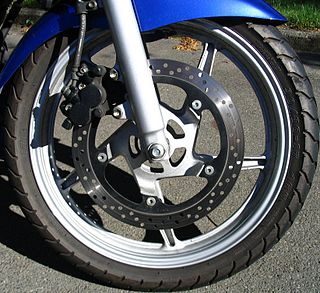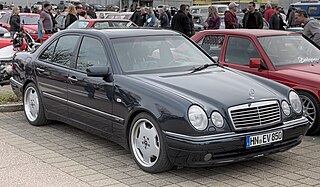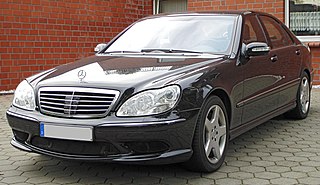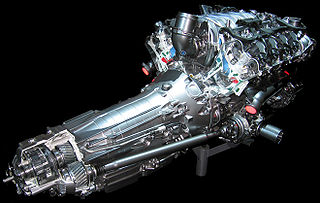
An anti-lock braking system (ABS) is a safety anti-skid braking system used on aircraft and on land vehicles, such as cars, motorcycles, trucks, and buses. ABS operates by preventing the wheels from locking up during braking, thereby maintaining tractive contact with the road surface and allowing the driver to maintain more control over the vehicle.

A brake is a mechanical device that inhibits motion by absorbing energy from a moving system. It is used for slowing or stopping a moving vehicle, wheel, axle, or to prevent its motion, most often accomplished by means of friction.

Electronic stability control (ESC), also referred to as electronic stability program (ESP) or dynamic stability control (DSC), is a computerized technology that improves a vehicle's stability by detecting and reducing loss of traction (skidding). When ESC detects loss of steering control, it automatically applies the brakes to help steer the vehicle where the driver intends to go. Braking is automatically applied to wheels individually, such as the outer front wheel to counter oversteer, or the inner rear wheel to counter understeer. Some ESC systems also reduce engine power until control is regained. ESC does not improve a vehicle's cornering performance; instead, it helps reduce the chance of the driver losing control of the vehicle.

Hydropneumatic suspension is a type of motor vehicle suspension system, invented by Paul Magès, produced by Citroën, and fitted to Citroën cars, as well as being used under licence by other car manufacturers. Similar systems are also widely used on modern tanks and other large military vehicles. The suspension was referred to as Suspension oléopneumatique in early literature, pointing to oil and air as its main components.

The Mercedes-Benz 300 SL is a two-seat sports car that was produced by Mercedes-Benz from 1954 to 1957 as a gullwinged coupé and from 1957 to 1963 as a roadster. The 300 SL traces its origins to the company's 1952 racing car, the W194, and was equipped with a mechanical direct fuel injection system that significantly increased the power output of its three-liter overhead camshaft straight-six engine.

The Mercedes-Benz GLK-Class is a Compact luxury crossover SUV produced from 2008 to 2015, debuting at the 2008 Beijing Auto Show. The name GLK is an acronym for Geländewagen Luxus Kompaktklasse, taking its name from the larger Mercedes-Benz GL-Class, which in turn was named after the G-Wagen or Geländewagen. Thus, the GL is the luxury-oriented version of the G, and GLK is the compact version of the GL.

The Mercedes-Benz W210 is the internal designation for a range of executive cars manufactured by Mercedes-Benz and marketed under the E-Class model name in both sedan/saloon (1995–2002) and station wagon/estate (1996–2003) configurations. W210 development started in 1988, three years after the W124's introduction.

The Mercedes-Benz R129 SL is a roadster which was produced by Mercedes-Benz from 1988 until 2001. The R129 replaced the R107 in 1989 and was in its turn replaced by the R230 SL-Class in 2002 for the 2003 model year.

Active Body Control, or ABC, is the Mercedes-Benz brand name used to describe electronically controlled hydropneumatic suspension.

4Matic is the marketing name of an all-wheel drive system developed by Mercedes-Benz. It is designed to increase traction in slippery conditions. With the introduction of the 2017 E 63 S sedan, Mercedes-AMG announced a performance-oriented variant of the system called AMG Performance 4MATIC+.

The Mercedes-Benz W221 is a chassis code of the fifth generation S-Class, produced from August 2005 until June 2013. The W221 S-Class was unveiled at the 2005 Frankfurt Motor Show as the successor of the Mercedes-Benz S-Class (W220) and the predecessor of the Mercedes-Benz S-Class (W222).

A hydraulic brake is an arrangement of braking mechanism which uses brake fluid, typically containing glycol ethers or diethylene glycol, to transfer pressure from the controlling mechanism to the braking mechanism.
An active suspension is a type of automotive suspension that uses an onboard control system to control the vertical movement of the vehicle's wheels and axles relative to the chassis or vehicle frame, rather than the conventional passive suspension that relies solely on large springs to maintain static support and dampen the vertical wheel movements caused by the road surface. Active suspensions are divided into two classes: true active suspensions, and adaptive or semi-active suspensions. While adaptive suspensions only vary shock absorber firmness to match changing road or dynamic conditions, active suspensions use some type of actuator to raise and lower the chassis independently at each wheel.

Brake-by-wire technology in the automotive industry is the ability to control brakes through electronic means, without a mechanical connection that transfers force to the physical braking system from a driver input apparatus such as a pedal or lever.

The Mercedes-Benz F 200"Imagination" coupe is a concept study by then Daimler-Benz unveiled at the 1996 Paris Motor Show. The goal was to show off innovations in control, design, and comfort in passenger cars. The car's exterior design was in part based on the, then, upcoming S-Class. This 2-door coupe also previewed the CL-Class coupe, which debuted in 1999.

The Mercedes-Benz C112 was an experimental mid-engine concept car built in 1991 by German automobile manufacturer Mercedes-Benz as a test bed, similar to the later versions of the C111. Despite using the same chassis code, it was not related to the W112 series of limousines and coupes of the 1960s. The C112 was intended to be the road-legal counterpart of the Sauber-built C11 Group C prototype race car developed for the 1990 World Sports-Prototype Championship.
Mercedes-Benz, commonly referred to simply as Mercedes and occasionally as Benz, is a German luxury and commercial vehicle brand that was founded in 1926. Mercedes-Benz AG is based in Stuttgart, Baden-Württemberg, Germany. Mercedes-Benz AG manufactures luxury vehicles and light commercial vehicles, all branded under the Mercedes-Benz name. From November 2019 onwards, the production of Mercedes-Benz-branded heavy commercial vehicles has been managed by Daimler Truck, which separated from the Mercedes-Benz Group to form an independent entity at the end of 2021.

The Mercedes-Benz GLA is a subcompact luxury crossover SUV manufactured and marketed by Mercedes-Benz over two generations. It is essentially the SUV equivalent of the A-Class, and the smallest SUV marketed by the brand. The production version was revealed in August 2013 ahead of the 2013 Frankfurt Auto Show in September 2013.

The Mercedes-Benz W222 is the sixth generation of the Mercedes Benz S-Class produced from 2013 to 2020, serving as the successor to the W221 S-Class and predecessor to the W223 S-Class. The W222 was designed in 2009 by Korean designer Il-hun Yoon, who drew inspiration from the Mercedes-Benz F700 concept car. The exterior design was developed by a team under the direction of the Slovenian car designer Robert Lešnik. The W222 has a similar design theme to the C-Class (W205) and E-Class (W213).

9G-Tronic is Mercedes-Benz's trademark name for its 9-speed automatic transmission, starting off with the W9A 700 as core model. The transmission debuted on the E 350 BlueTEC in 2013, and successively replaced both the 7-speed 7G-Tronic (PLUS) transmission and the 5-speed 5G-Tronic transmission. It includes versions for a maximum input torque of 1,000 N⋅m (738 lb⋅ft).

















